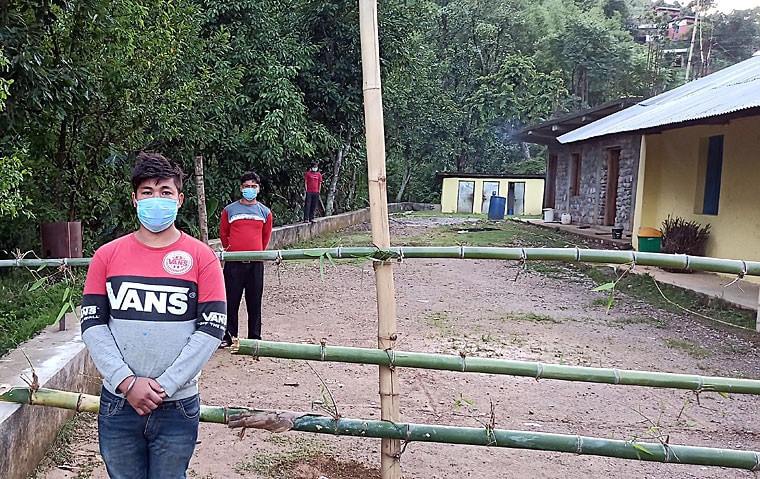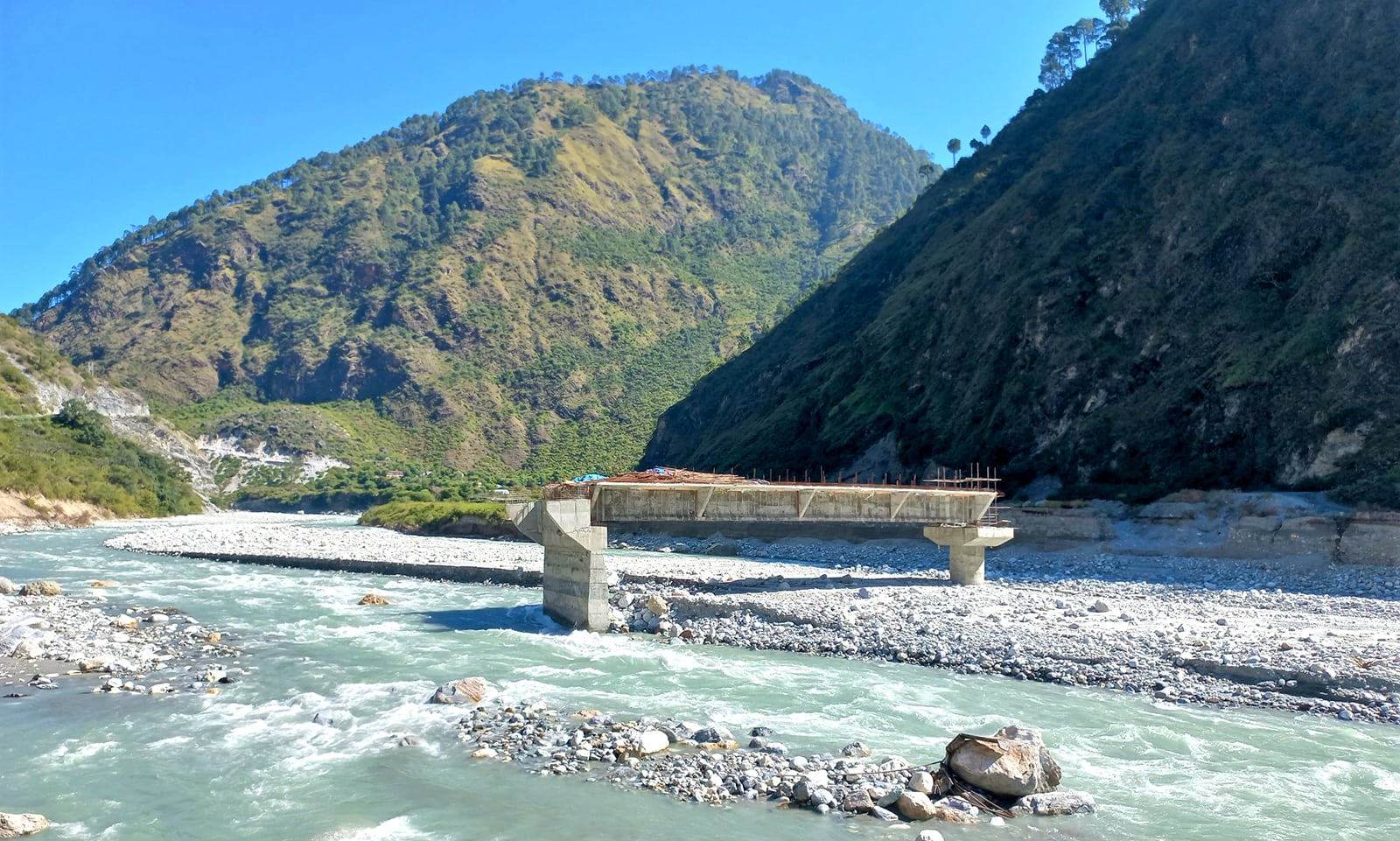Western Nepal may be seeing spike in COVID-19 as returnees from India head home without tests
Ramu Sapkota: Centre For Investigative Journalism-Nepal
Nepal’s new budget has allocated Rs12 billion to improve healthcare facilities, that is money urgently needed in western Nepal where the public health infrastructure remains fragile to the point that school buildings have been used as risky makeshift quarantine centres.

One set of returnees from India waiting for the jeep to take them on the final leg of their journey home. Photos: Kamal Paudel
Here in Gulmi and Baglung districts, the classrooms serving as quarantine centres are used to isolate Nepalis who have returned from India after losing their jobs. Many lack proper medical equipment, food, drinking water and sanitation facilities.
Some are so crowded that they are incubators to the virus themselves. Despite government directives to ensure proper quarantining measures, none have been implemented so far in these makeshift centres.
For example, the guidelines stipulate that every 100 people in quarantine must have at least one doctor, one nurse and one paramedic. They must get health checks twice a day to see if they have fever, and should be referred to hospitals if they develop symptoms.
Saraswati Secondary School in Musikot of Gulmi has 18 returnees who have been isolated since 28 May after harrowing journeys across India and waiting for weeks at the sealed border. They do not have proper beds, or mosquito nets, cannot always maintain distance.
“We have to share the same tap and dirty toilets. We have to sleep on the floor and need families to bring us food and water,” says Govinda Bhattarai, who returned from Hosiarpur in India after losing his job.
Not all have returned from India, some who have come from Kathmandu are also in quarantine. Like Keshab Ghimire, his wife and nine-year-old son who had returned after medical treatment in Kathmandu and were put in isolation in a school. There are no facilities, no health personnel, they have had to bring mattresses from home and they cook by themselves in the converted classroom.

Quarantined in a school in Thamdada of Gulmi after spending many weeks returning from India, these migrant workers, like many others, never got a health checkup or a COVID-19 test.
Only a few of the returnees had their temperatures checked, and none have had PCR tests, leading to fears that the centre could be a hotbed for COVID-19 transmission. The only thermal gun available does not work anymore, and the few Personal Protective Equipment (PPE) are being washed and reused.
“The municipality has not sent medical professionals or security people,” says Bishnuprasad Kharel, a teacher who has to monitors the school’s quarantine. “Those in isolation could escape if they wanted to, and that would pose a risk to the community.”
Kharel also says the lack of support from the municipality has forced people to take matters into their own hands. “We have no expertise in quarantine management and we lack logistical support from the municipality,” he adds.
In the same municipality, Rudrawati Primary School is isolating 10 returnees from India and faces the same problems of lack of water and proper toilets. Returnees are forced to sleep on the floor and get their own provisions. None of those quarantined has been medically checked.
There is also a shortage of health workers, with none available in the 91 quarantine centres and one municipal isolation ward in Musikot. Mayor Somnath Sapkota says: “We requested the provincial government to provide one MBBS-qualified doctor, but have received no response so far.”
As India relaxes its lockdown, tens of thousands more Nepalis have been arriving at the border every day and many of them will finding their way up to Gulmi and Baglung – two districts with some of the highest outmigration rates in Nepal.
Sunil Rana made an arduous journey from Gurgaon in India to the Nepal border and after waiting there many days arrived in Musikot only to be quarantined in a local school. “I never got a health check anywhere along the way, and I have still not been tested,” he says.
This month alone, 393 people have arrived in Musikot from India after crossing the border at Sunauli. In the month before that there were 374 from India and 33 from overseas via Kathmandu airport. With a new wave of one thousand people expected to arrive from India in Gulmi in the coming week, the district is just not prepared to deal with the numbers.
The municipality has set aside Rs10 million for relief to vulnerable families, buying medical equipment and other paraphernalia. Most of that money has been spent, and there is nothing left for the upkeep of quarantine centres.
Baglung district is also in danger of being overwhelmed by a new influx of returnees from India. In Galkot Municipality, Ratnalaxmi Secondary School has 17 people and Manewa Basic School houses nine, some of whom are children.

These Nepali workers finally got home to Musikot after an ardous journey from India, and are now quarantined in a local school without proper sanitation and water.
“No medical tests have been done, and many are crammed into one room and forced to use the same taps and toilets. Those in isolation have to manage food and water by themselves.” says Tham Bahadur BK who made a difficult journey back from in India.
Chief Consultant of Sukraraj Tropical and Infectious Disease Hospital in Kathmandu Anup Bastola says the unsanitary and crowded conditions do not just expose healthy people to the virus, but they could also contact other infections including dengue, malaria, diarrhoea and tuberculosis.
“We should actually be pushing for home quarantine because it will be safer, and only those with COVID-19 symptoms should be taken to hospitals isolation wards,” says Bastola.
Two years ago, the government had stipulated that every one of the 763 municipalities in Nepal have at least one MBBS doctor, but that policy never got implemented. Districts like Gulmi are now suffering because of the lack of trained medical professionals during the pandemic.
The former head of the Epidemiology and Disease Control Department in Kathmandu Baburam Marasini says the whole of western Nepal is in danger of being a hot spot for community spread of COVID-19 as more and more people returning from India go back to their home villages without tests and quarantines.
So far, it is just the workers from India who have returned. In another few weeks, thousands of workers from the Gulf and Malaysia are also expected to start arriving, and the government has asked local governments to arrange for their quarantines.
Mayor Sapkota in Musikot blames the situation on the central government not doing enough during the lockdown to prepare for the influx of workers from abroad: “They asked us to follow WHO guidelines, but did not take into account the resources available on the ground. There was no provision made for local condit



